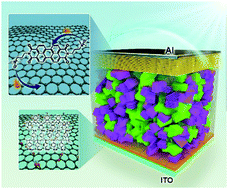Solution-processable n-doped graphene-containing cathode interfacial materials for high-performance organic solar cells†
Abstract
Interface engineering is a critical factor in achieving high photovoltaic performances for large-area, printable, flexible and low cost organic solar cells (OSCs). Herein, we developed a solution-processable n-doped graphene cathode interfacial material (CIM) PDINO–G for OSCs by adding graphene to the classic material PDINO ((N,N-dimethyl-ammonium N-oxide)propyl perylene diimide). The dispersed graphene in PDINO–G was n-doped by the nitroxide radical of N-oxide in PDINO, which was certified by the ESR, Raman spectroscopy and XPS results. The n-doped PDINO–G CIM possessed increased conductivity, lower work function, reduced charge recombination and increased charge extraction rate. Previously, n-doped graphene was prepared only on the surface of chemical vapor-deposited (CVD) graphene films without solution processability. The effect of the CIM on the photovoltaic performance of OSCs was studied by selecting the photovoltaic model system of PTQ10 as the donor and IDIC-2F as the acceptor. The OSCs based on PTQ10:IDIC-2F with PDINO–G CIM demonstrated the best power conversion efficiency (PCE) of 13.01%, which was significantly enhanced in comparison with that of the devices without graphene modification on the PDINO CIM (12.23%). The universality of the high performance PDINO–G CIM was verified in two other photovoltaic systems based on PTQ10:IDIC and PM6:Y6. Especially, the single junction bulk heterojunction OSCs based on PM6:Y6 with PDINO–G CIM displayed a high PCE of 16.52% (average PCE of 16.3 ± 0.2%). The results indicate that the n-doped PDINO–G is an excellent CIM for OSCs. Furthermore, this PDINO-doped graphene can be applied in other optoelectronic devices such as tandem OSCs, organic light-emitting diodes, and high-performance perovskite solar cells as a cathode interfacial material considering its advantages of solution processability, low work function and high conductivity.



 Please wait while we load your content...
Please wait while we load your content...